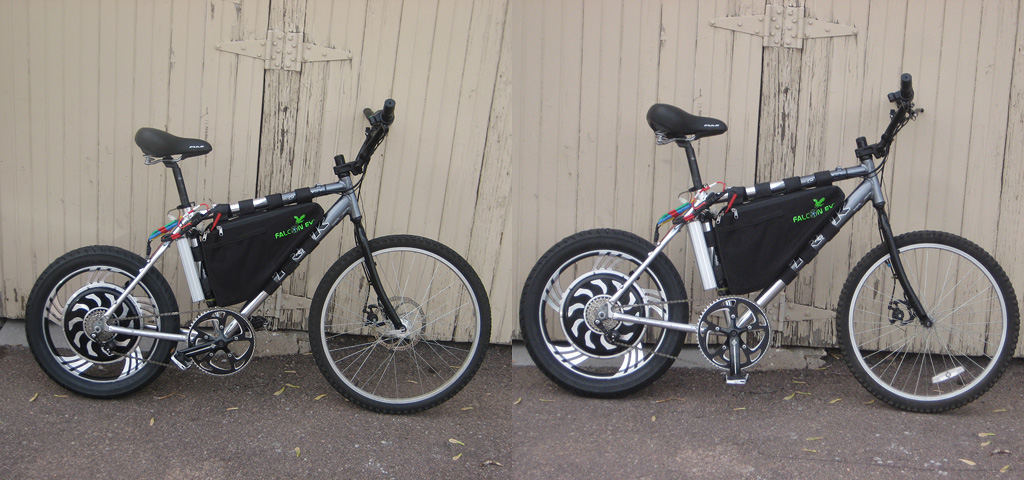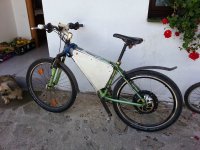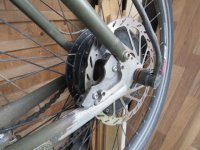Toecutter,
You have so many questions, I can only answer a few.
I had 700 miles on my 2013 Mac 6T on a 27.5 inch wheel at 48 volts, running at 22 amps before it needed work, and that is , Only , because I road up a steep mountain that was dirt and gravel on the steepest last 1.6 or so miles of it.
It over heated, but did I did seem like it did since when it stopped I got off and felt the motor and it did not feel hot.
I thought I stripped the gears, or the clutch , but after a couple of months I did some tests and found out that one of the Hall Sensors was not working. ( I had melted the solder of that one Hall Sensor )
I got it repaired and am riding and loving it now .
So Gears not a problem, clutch not a problem, just over heated the solder .
The likely hood of you doing the same thing is much less now Because ...
The new Mac Motor has a white wire that is a temp sensor, and when hooked up to a Cycle Analyst V3 , through a Infineon Controller, the vendor that sells you the C.A. V3 can adjust it to shut off the motor before it over heats ( not on C.A. V2.3 model ) just the V3 one .
So now you have a , almost , bullet proof Hub Motor when the Three Parts are used together. You still should be careful if you go up long and or long and steep hills, if so get the 12 t or 10 t for more speed.
With the New Mac motor you can also spend $ 30 more and get the one that accepts cassettes .
I have a smaller motor, but have gone back to riding the Mac, for more speed, and less stress , on the smaller motor I am always pushing it to its limits, on the Mac there is plenty of spare power .
Mac's are said to be able to handle 1200-1500 watts for long periods.
Not much cogging / resistance when not under power and just using leg power, however heaver weight of a motor/battery etc is not much fun.
I can and often run the Mac on just a few hundred watts as well to get longer range.
* Note , if you get a Mac Motor that accepts the older freewheel then you could be getting a previous version Mac with, No , white temp sensor wire , get the New Mac that accepts a cassette to get the white temp sensor wire *
Mac motor, Infineon 12 fet controller, Cycle Analyst V.3 . Good Battery able to handle 25 + amps.
The Toecutter said:
I've read through most of this topic and still have a few unanswered questions for those here who have abused their MAC motors.
Is cell_man still the go-to guy for these motors to get them into the U.S. or are better options available? I'd prefer a MAC8T integrated into a double-walled 26" rim with 14ga spokes, and it needs to be strong enough to be "bulletproof" for long trips.
How many miles of use did you get out of the MAC motors before they needed repair/replacement? How long do the new composite clutches/gears last under the abuse you have put them through?
What I've got in mind:
I am planning to put together an electric-assist tadpole-layout velomobile using a PAS and THUN torque-sensing bottom bracket with Cycle Analyst v3. I currently have a KMX frame with adam333's front suspension kit. There is no rear suspension, but most of the mass will be over the front axle line anyway. The rear wheel is 26" and I have a Schwalbe Marathon Plus on it. Fully laden weight with myself plus clothing/tools/food/water/camping gear is expected to be 300 lbs, and I expect my first body shell to have a CdA of around 1.5 ft^2. The velomobile itself will weigh no more than 100 lbs.
I want it to be able to operate on pedal-only mode if the battery runs dead, and I will also have a thumb switch for a throttle, limited to 20 mph, in case I break the chain. This will minimize the risk of ever being left stranded due to any motor/drivetrain component failure. I'm looking at perhaps 300W at the rear wheel to cruise at 30 mph on the flat with a pedal cadence of 90, with a top end of 40 mph or so at 120 cadence. I have in mind setting a MAC8T up with a Sunrace 9sp 11-40T gear cluster in the rear with a single 46T cog up front and running the motor/controller at 60V/40A.
The idea is to have a wide enough gearing range that with the motor off, I could still pedal it up fairly steep hills at ~5 mph, and with the motor on, cruise at 30 mph at a comfortable cadence with 100-150W pedal output with the motor doing the rest(maybe 250-300W electrical input), and top out at 40 mph. Best of all, it will be 100% legal as an electric "bicycle" in the state that I reside under this setup, and in states where it is not legal, the motor will be hidden by both the sprocket set and a rear disc brake and I can fully disengage the clutch and pedal it like a normal "bicycle" when needed, and still probably reach the same 40 mph top speed on the flat with no electric assist while pedaling my ass off.
I think the MAC motor will work for this application.
Theoretically I could accelerate from 0-30 mph in about 6.5 seconds pedaling with 500W and letting the motor throw in the rest being fed 2.4 kW from the controller, with the max primary current as well as the phase current both set at 40A(so as not to damage the clutch or gears on launch). This acceleration would match some of the slowest automobiles on the road, and while I would like more acceleration than that, I still do value reliability over performance.
Maybe one day I'll have to try to re-design this motor to get what I want out of it(5+ kW peak on a regular basis without damage would be nice), but that's not even going to be a possibility unless/until I make the purchase and do some testing of my own. I'm tempted to plunk down $1200 for a LightningRod's middrive for trikes along with $1500 for a Rohloff 500/14 internal gear hub instead, but this MAC8T would allow me to avoid most of that expense/headache for now while allowing this vehicle to be a practical form of transportation with a lot less components to break.
Think the MAC is a good choice for my application?





